Economics Assignment: Analysis of China's Economic Development
VerifiedAdded on 2020/05/16
|13
|3562
|109
Homework Assignment
AI Summary
This economics assignment provides a comprehensive analysis of China's economic development, covering key aspects such as its GDP growth, market reforms, and integration into the global economy. The assignment explores China's transformation from a developing nation to a major economic power, examining the impact of its entry into the WTO and the implementation of policies like the 'New Normal.' It also delves into the views of key figures like Wen Jiabao and Xi Jinping on China's economic trajectory, and the evolving relationship between China and the United States, including trade imbalances and economic challenges. The assignment utilizes figures and data to illustrate economic trends, providing a detailed overview of China's economic landscape, its challenges, and future prospects.
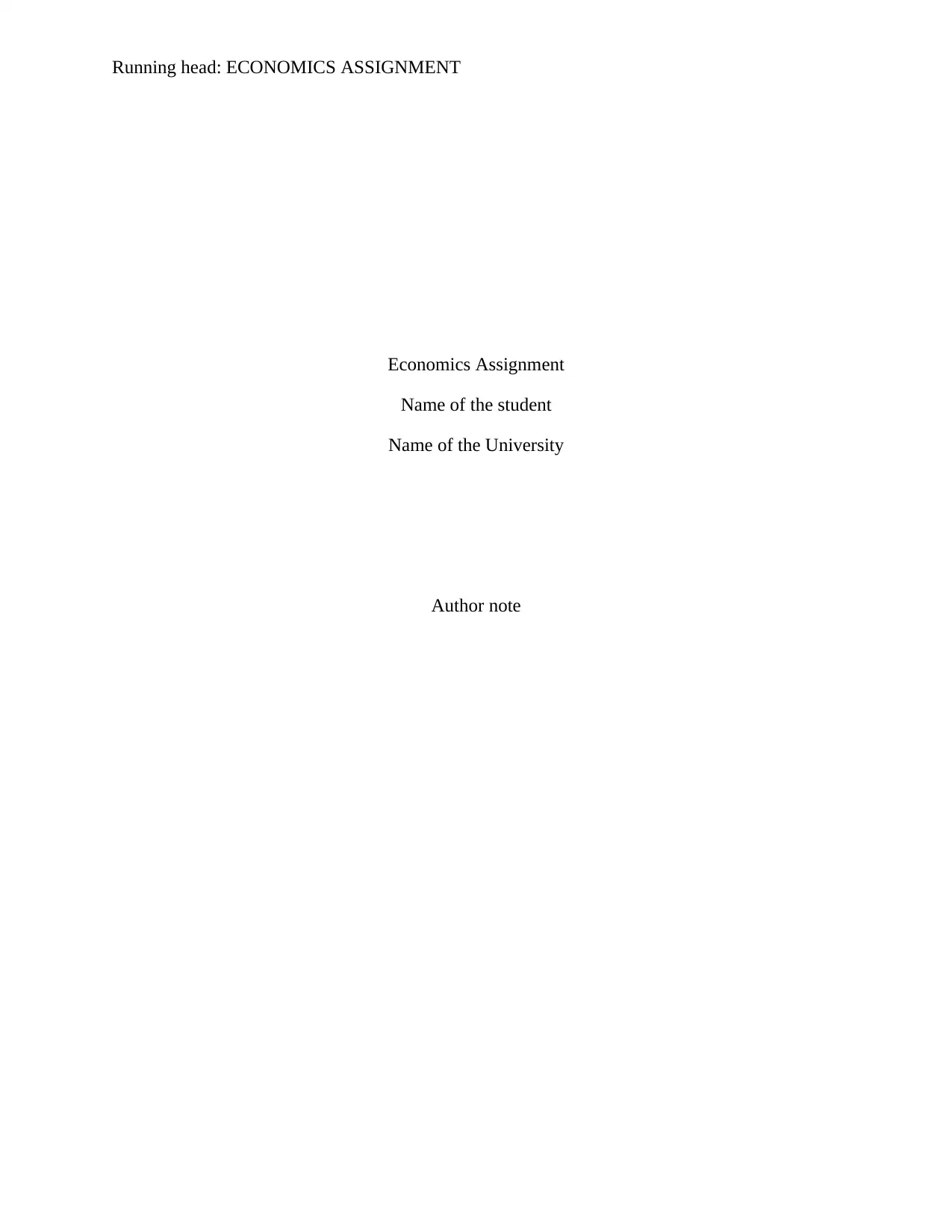
Running head: ECONOMICS ASSIGNMENT
Economics Assignment
Name of the student
Name of the University
Author note
Economics Assignment
Name of the student
Name of the University
Author note
Paraphrase This Document
Need a fresh take? Get an instant paraphrase of this document with our AI Paraphraser
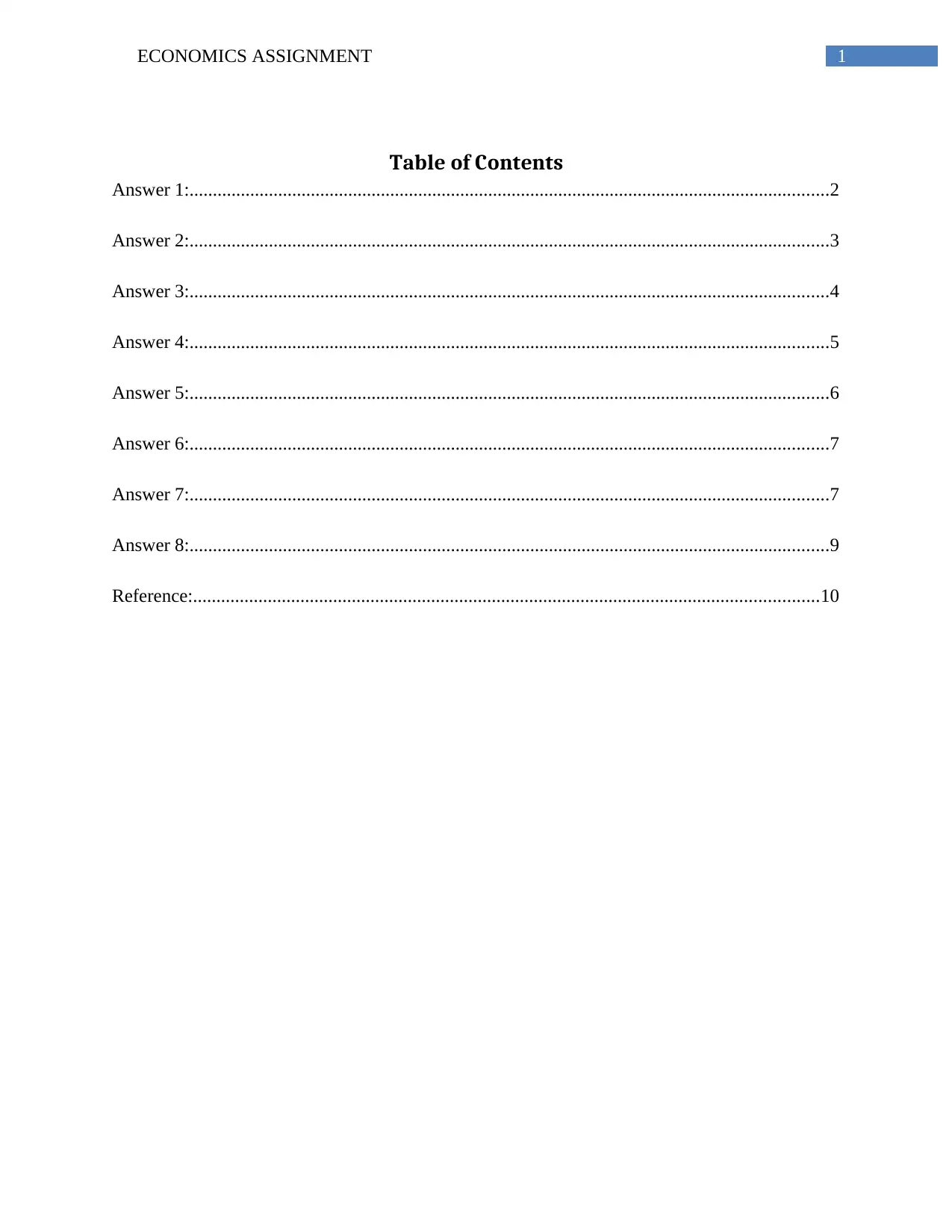
1ECONOMICS ASSIGNMENT
Table of Contents
Answer 1:.........................................................................................................................................2
Answer 2:.........................................................................................................................................3
Answer 3:.........................................................................................................................................4
Answer 4:.........................................................................................................................................5
Answer 5:.........................................................................................................................................6
Answer 6:.........................................................................................................................................7
Answer 7:.........................................................................................................................................7
Answer 8:.........................................................................................................................................9
Reference:......................................................................................................................................10
Table of Contents
Answer 1:.........................................................................................................................................2
Answer 2:.........................................................................................................................................3
Answer 3:.........................................................................................................................................4
Answer 4:.........................................................................................................................................5
Answer 5:.........................................................................................................................................6
Answer 6:.........................................................................................................................................7
Answer 7:.........................................................................................................................................7
Answer 8:.........................................................................................................................................9
Reference:......................................................................................................................................10
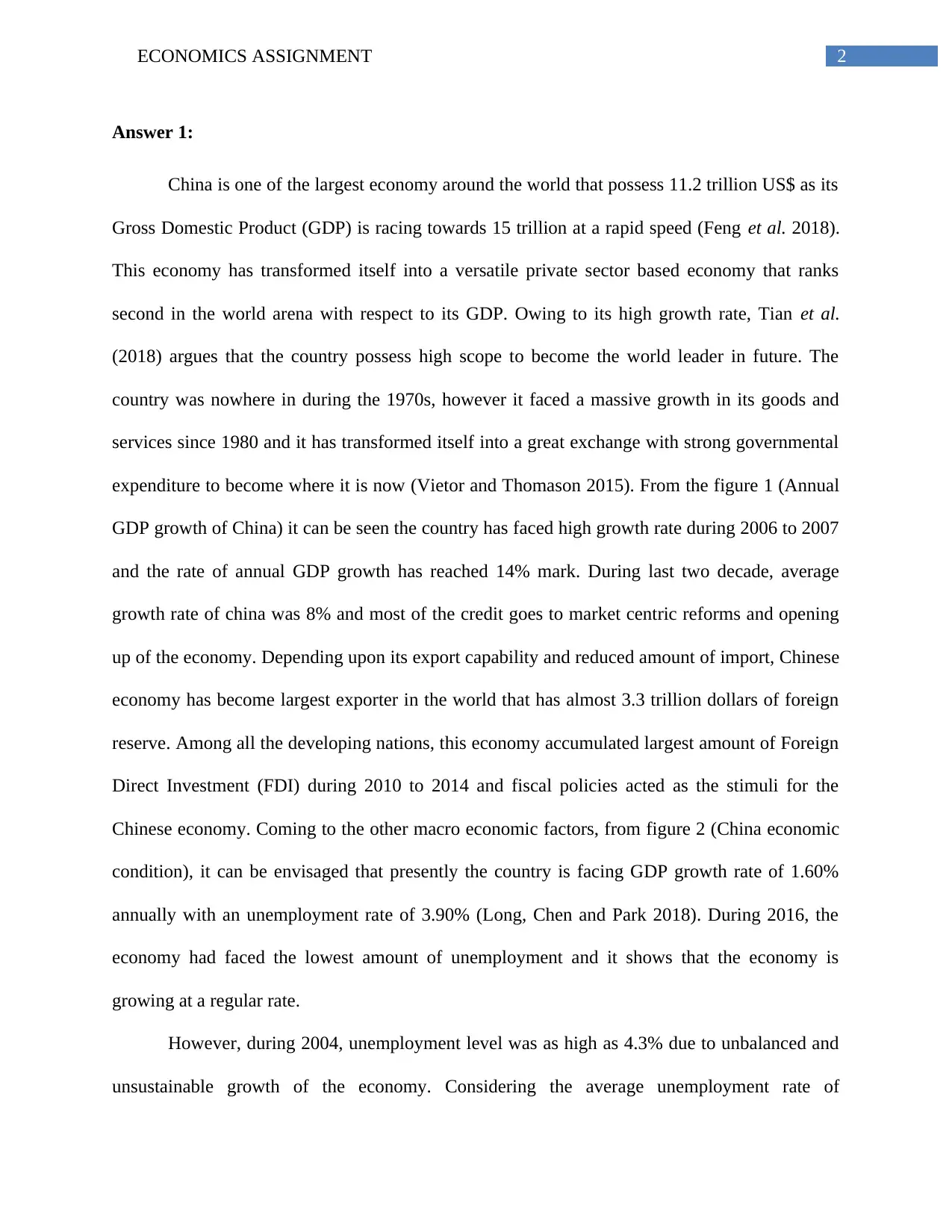
2ECONOMICS ASSIGNMENT
Answer 1:
China is one of the largest economy around the world that possess 11.2 trillion US$ as its
Gross Domestic Product (GDP) is racing towards 15 trillion at a rapid speed (Feng et al. 2018).
This economy has transformed itself into a versatile private sector based economy that ranks
second in the world arena with respect to its GDP. Owing to its high growth rate, Tian et al.
(2018) argues that the country possess high scope to become the world leader in future. The
country was nowhere in during the 1970s, however it faced a massive growth in its goods and
services since 1980 and it has transformed itself into a great exchange with strong governmental
expenditure to become where it is now (Vietor and Thomason 2015). From the figure 1 (Annual
GDP growth of China) it can be seen the country has faced high growth rate during 2006 to 2007
and the rate of annual GDP growth has reached 14% mark. During last two decade, average
growth rate of china was 8% and most of the credit goes to market centric reforms and opening
up of the economy. Depending upon its export capability and reduced amount of import, Chinese
economy has become largest exporter in the world that has almost 3.3 trillion dollars of foreign
reserve. Among all the developing nations, this economy accumulated largest amount of Foreign
Direct Investment (FDI) during 2010 to 2014 and fiscal policies acted as the stimuli for the
Chinese economy. Coming to the other macro economic factors, from figure 2 (China economic
condition), it can be envisaged that presently the country is facing GDP growth rate of 1.60%
annually with an unemployment rate of 3.90% (Long, Chen and Park 2018). During 2016, the
economy had faced the lowest amount of unemployment and it shows that the economy is
growing at a regular rate.
However, during 2004, unemployment level was as high as 4.3% due to unbalanced and
unsustainable growth of the economy. Considering the average unemployment rate of
Answer 1:
China is one of the largest economy around the world that possess 11.2 trillion US$ as its
Gross Domestic Product (GDP) is racing towards 15 trillion at a rapid speed (Feng et al. 2018).
This economy has transformed itself into a versatile private sector based economy that ranks
second in the world arena with respect to its GDP. Owing to its high growth rate, Tian et al.
(2018) argues that the country possess high scope to become the world leader in future. The
country was nowhere in during the 1970s, however it faced a massive growth in its goods and
services since 1980 and it has transformed itself into a great exchange with strong governmental
expenditure to become where it is now (Vietor and Thomason 2015). From the figure 1 (Annual
GDP growth of China) it can be seen the country has faced high growth rate during 2006 to 2007
and the rate of annual GDP growth has reached 14% mark. During last two decade, average
growth rate of china was 8% and most of the credit goes to market centric reforms and opening
up of the economy. Depending upon its export capability and reduced amount of import, Chinese
economy has become largest exporter in the world that has almost 3.3 trillion dollars of foreign
reserve. Among all the developing nations, this economy accumulated largest amount of Foreign
Direct Investment (FDI) during 2010 to 2014 and fiscal policies acted as the stimuli for the
Chinese economy. Coming to the other macro economic factors, from figure 2 (China economic
condition), it can be envisaged that presently the country is facing GDP growth rate of 1.60%
annually with an unemployment rate of 3.90% (Long, Chen and Park 2018). During 2016, the
economy had faced the lowest amount of unemployment and it shows that the economy is
growing at a regular rate.
However, during 2004, unemployment level was as high as 4.3% due to unbalanced and
unsustainable growth of the economy. Considering the average unemployment rate of
⊘ This is a preview!⊘
Do you want full access?
Subscribe today to unlock all pages.

Trusted by 1+ million students worldwide
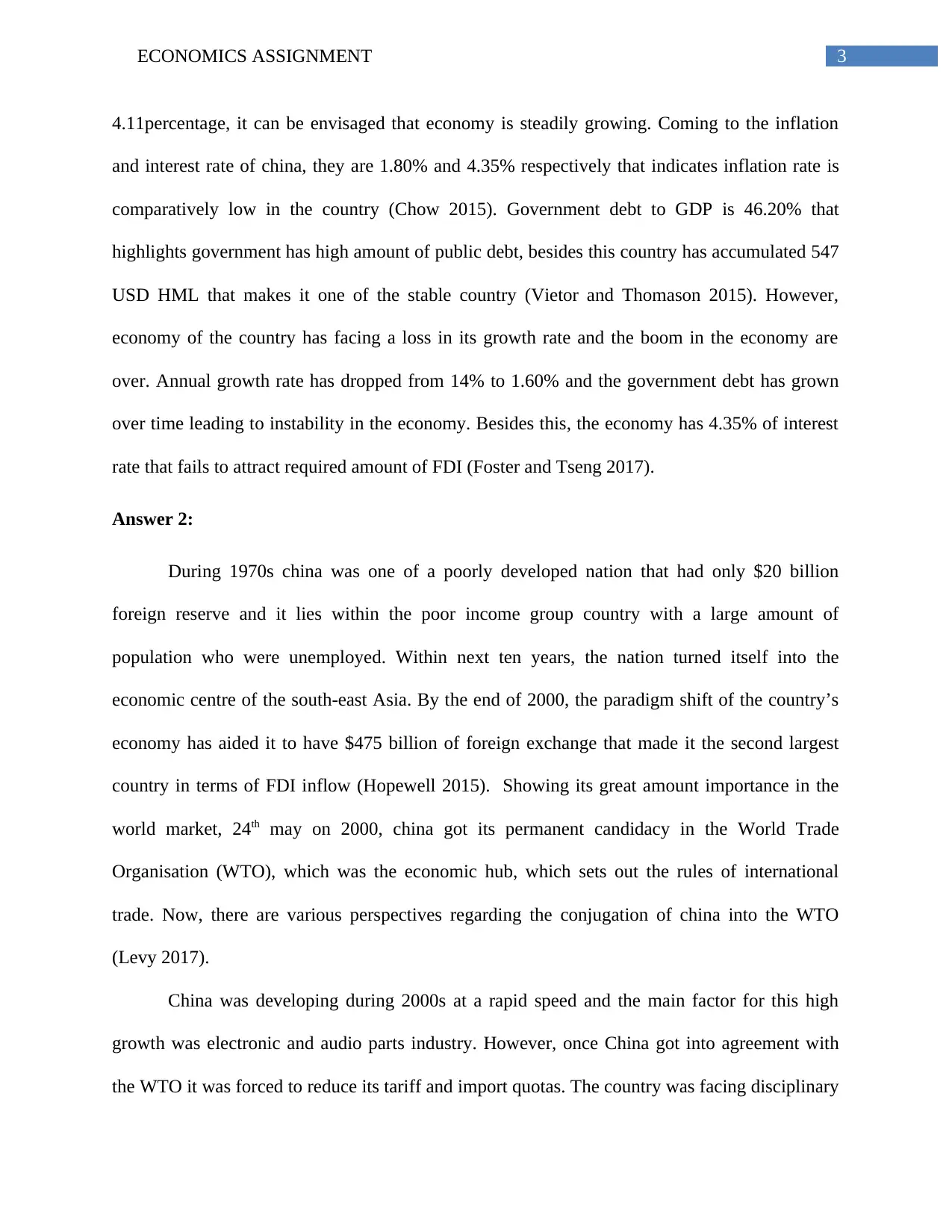
3ECONOMICS ASSIGNMENT
4.11percentage, it can be envisaged that economy is steadily growing. Coming to the inflation
and interest rate of china, they are 1.80% and 4.35% respectively that indicates inflation rate is
comparatively low in the country (Chow 2015). Government debt to GDP is 46.20% that
highlights government has high amount of public debt, besides this country has accumulated 547
USD HML that makes it one of the stable country (Vietor and Thomason 2015). However,
economy of the country has facing a loss in its growth rate and the boom in the economy are
over. Annual growth rate has dropped from 14% to 1.60% and the government debt has grown
over time leading to instability in the economy. Besides this, the economy has 4.35% of interest
rate that fails to attract required amount of FDI (Foster and Tseng 2017).
Answer 2:
During 1970s china was one of a poorly developed nation that had only $20 billion
foreign reserve and it lies within the poor income group country with a large amount of
population who were unemployed. Within next ten years, the nation turned itself into the
economic centre of the south-east Asia. By the end of 2000, the paradigm shift of the country’s
economy has aided it to have $475 billion of foreign exchange that made it the second largest
country in terms of FDI inflow (Hopewell 2015). Showing its great amount importance in the
world market, 24th may on 2000, china got its permanent candidacy in the World Trade
Organisation (WTO), which was the economic hub, which sets out the rules of international
trade. Now, there are various perspectives regarding the conjugation of china into the WTO
(Levy 2017).
China was developing during 2000s at a rapid speed and the main factor for this high
growth was electronic and audio parts industry. However, once China got into agreement with
the WTO it was forced to reduce its tariff and import quotas. The country was facing disciplinary
4.11percentage, it can be envisaged that economy is steadily growing. Coming to the inflation
and interest rate of china, they are 1.80% and 4.35% respectively that indicates inflation rate is
comparatively low in the country (Chow 2015). Government debt to GDP is 46.20% that
highlights government has high amount of public debt, besides this country has accumulated 547
USD HML that makes it one of the stable country (Vietor and Thomason 2015). However,
economy of the country has facing a loss in its growth rate and the boom in the economy are
over. Annual growth rate has dropped from 14% to 1.60% and the government debt has grown
over time leading to instability in the economy. Besides this, the economy has 4.35% of interest
rate that fails to attract required amount of FDI (Foster and Tseng 2017).
Answer 2:
During 1970s china was one of a poorly developed nation that had only $20 billion
foreign reserve and it lies within the poor income group country with a large amount of
population who were unemployed. Within next ten years, the nation turned itself into the
economic centre of the south-east Asia. By the end of 2000, the paradigm shift of the country’s
economy has aided it to have $475 billion of foreign exchange that made it the second largest
country in terms of FDI inflow (Hopewell 2015). Showing its great amount importance in the
world market, 24th may on 2000, china got its permanent candidacy in the World Trade
Organisation (WTO), which was the economic hub, which sets out the rules of international
trade. Now, there are various perspectives regarding the conjugation of china into the WTO
(Levy 2017).
China was developing during 2000s at a rapid speed and the main factor for this high
growth was electronic and audio parts industry. However, once China got into agreement with
the WTO it was forced to reduce its tariff and import quotas. The country was facing disciplinary
Paraphrase This Document
Need a fresh take? Get an instant paraphrase of this document with our AI Paraphraser
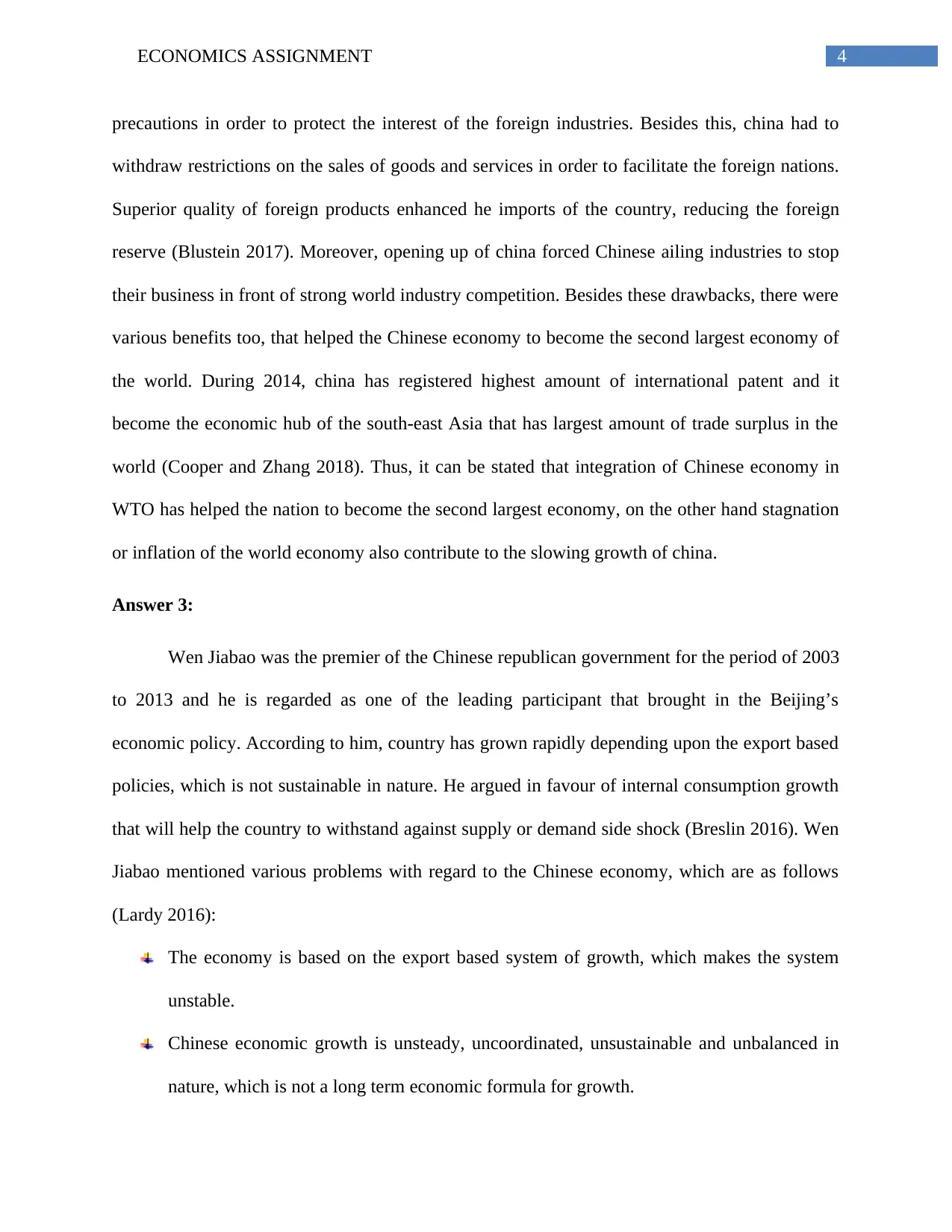
4ECONOMICS ASSIGNMENT
precautions in order to protect the interest of the foreign industries. Besides this, china had to
withdraw restrictions on the sales of goods and services in order to facilitate the foreign nations.
Superior quality of foreign products enhanced he imports of the country, reducing the foreign
reserve (Blustein 2017). Moreover, opening up of china forced Chinese ailing industries to stop
their business in front of strong world industry competition. Besides these drawbacks, there were
various benefits too, that helped the Chinese economy to become the second largest economy of
the world. During 2014, china has registered highest amount of international patent and it
become the economic hub of the south-east Asia that has largest amount of trade surplus in the
world (Cooper and Zhang 2018). Thus, it can be stated that integration of Chinese economy in
WTO has helped the nation to become the second largest economy, on the other hand stagnation
or inflation of the world economy also contribute to the slowing growth of china.
Answer 3:
Wen Jiabao was the premier of the Chinese republican government for the period of 2003
to 2013 and he is regarded as one of the leading participant that brought in the Beijing’s
economic policy. According to him, country has grown rapidly depending upon the export based
policies, which is not sustainable in nature. He argued in favour of internal consumption growth
that will help the country to withstand against supply or demand side shock (Breslin 2016). Wen
Jiabao mentioned various problems with regard to the Chinese economy, which are as follows
(Lardy 2016):
The economy is based on the export based system of growth, which makes the system
unstable.
Chinese economic growth is unsteady, uncoordinated, unsustainable and unbalanced in
nature, which is not a long term economic formula for growth.
precautions in order to protect the interest of the foreign industries. Besides this, china had to
withdraw restrictions on the sales of goods and services in order to facilitate the foreign nations.
Superior quality of foreign products enhanced he imports of the country, reducing the foreign
reserve (Blustein 2017). Moreover, opening up of china forced Chinese ailing industries to stop
their business in front of strong world industry competition. Besides these drawbacks, there were
various benefits too, that helped the Chinese economy to become the second largest economy of
the world. During 2014, china has registered highest amount of international patent and it
become the economic hub of the south-east Asia that has largest amount of trade surplus in the
world (Cooper and Zhang 2018). Thus, it can be stated that integration of Chinese economy in
WTO has helped the nation to become the second largest economy, on the other hand stagnation
or inflation of the world economy also contribute to the slowing growth of china.
Answer 3:
Wen Jiabao was the premier of the Chinese republican government for the period of 2003
to 2013 and he is regarded as one of the leading participant that brought in the Beijing’s
economic policy. According to him, country has grown rapidly depending upon the export based
policies, which is not sustainable in nature. He argued in favour of internal consumption growth
that will help the country to withstand against supply or demand side shock (Breslin 2016). Wen
Jiabao mentioned various problems with regard to the Chinese economy, which are as follows
(Lardy 2016):
The economy is based on the export based system of growth, which makes the system
unstable.
Chinese economic growth is unsteady, uncoordinated, unsustainable and unbalanced in
nature, which is not a long term economic formula for growth.
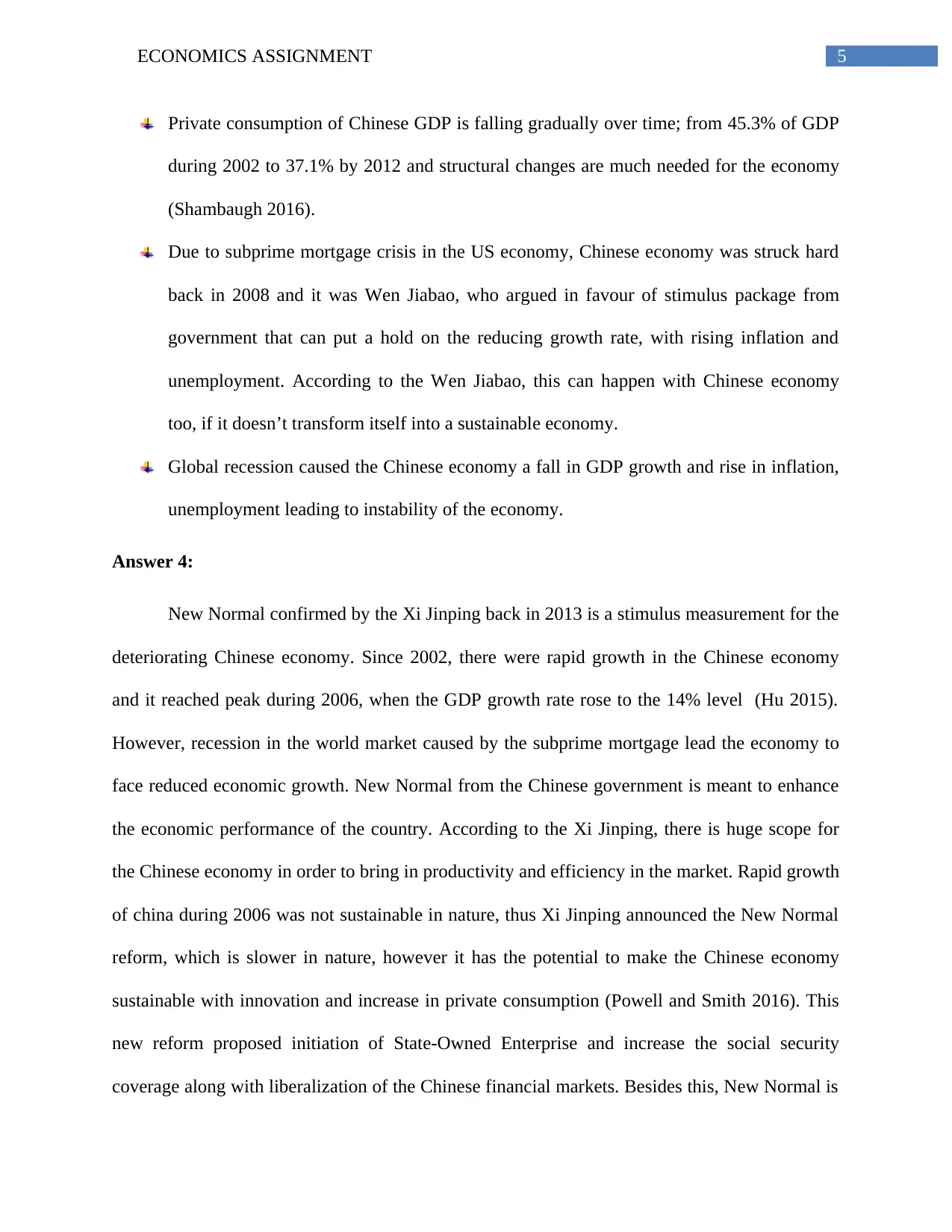
5ECONOMICS ASSIGNMENT
Private consumption of Chinese GDP is falling gradually over time; from 45.3% of GDP
during 2002 to 37.1% by 2012 and structural changes are much needed for the economy
(Shambaugh 2016).
Due to subprime mortgage crisis in the US economy, Chinese economy was struck hard
back in 2008 and it was Wen Jiabao, who argued in favour of stimulus package from
government that can put a hold on the reducing growth rate, with rising inflation and
unemployment. According to the Wen Jiabao, this can happen with Chinese economy
too, if it doesn’t transform itself into a sustainable economy.
Global recession caused the Chinese economy a fall in GDP growth and rise in inflation,
unemployment leading to instability of the economy.
Answer 4:
New Normal confirmed by the Xi Jinping back in 2013 is a stimulus measurement for the
deteriorating Chinese economy. Since 2002, there were rapid growth in the Chinese economy
and it reached peak during 2006, when the GDP growth rate rose to the 14% level (Hu 2015).
However, recession in the world market caused by the subprime mortgage lead the economy to
face reduced economic growth. New Normal from the Chinese government is meant to enhance
the economic performance of the country. According to the Xi Jinping, there is huge scope for
the Chinese economy in order to bring in productivity and efficiency in the market. Rapid growth
of china during 2006 was not sustainable in nature, thus Xi Jinping announced the New Normal
reform, which is slower in nature, however it has the potential to make the Chinese economy
sustainable with innovation and increase in private consumption (Powell and Smith 2016). This
new reform proposed initiation of State-Owned Enterprise and increase the social security
coverage along with liberalization of the Chinese financial markets. Besides this, New Normal is
Private consumption of Chinese GDP is falling gradually over time; from 45.3% of GDP
during 2002 to 37.1% by 2012 and structural changes are much needed for the economy
(Shambaugh 2016).
Due to subprime mortgage crisis in the US economy, Chinese economy was struck hard
back in 2008 and it was Wen Jiabao, who argued in favour of stimulus package from
government that can put a hold on the reducing growth rate, with rising inflation and
unemployment. According to the Wen Jiabao, this can happen with Chinese economy
too, if it doesn’t transform itself into a sustainable economy.
Global recession caused the Chinese economy a fall in GDP growth and rise in inflation,
unemployment leading to instability of the economy.
Answer 4:
New Normal confirmed by the Xi Jinping back in 2013 is a stimulus measurement for the
deteriorating Chinese economy. Since 2002, there were rapid growth in the Chinese economy
and it reached peak during 2006, when the GDP growth rate rose to the 14% level (Hu 2015).
However, recession in the world market caused by the subprime mortgage lead the economy to
face reduced economic growth. New Normal from the Chinese government is meant to enhance
the economic performance of the country. According to the Xi Jinping, there is huge scope for
the Chinese economy in order to bring in productivity and efficiency in the market. Rapid growth
of china during 2006 was not sustainable in nature, thus Xi Jinping announced the New Normal
reform, which is slower in nature, however it has the potential to make the Chinese economy
sustainable with innovation and increase in private consumption (Powell and Smith 2016). This
new reform proposed initiation of State-Owned Enterprise and increase the social security
coverage along with liberalization of the Chinese financial markets. Besides this, New Normal is
⊘ This is a preview!⊘
Do you want full access?
Subscribe today to unlock all pages.

Trusted by 1+ million students worldwide
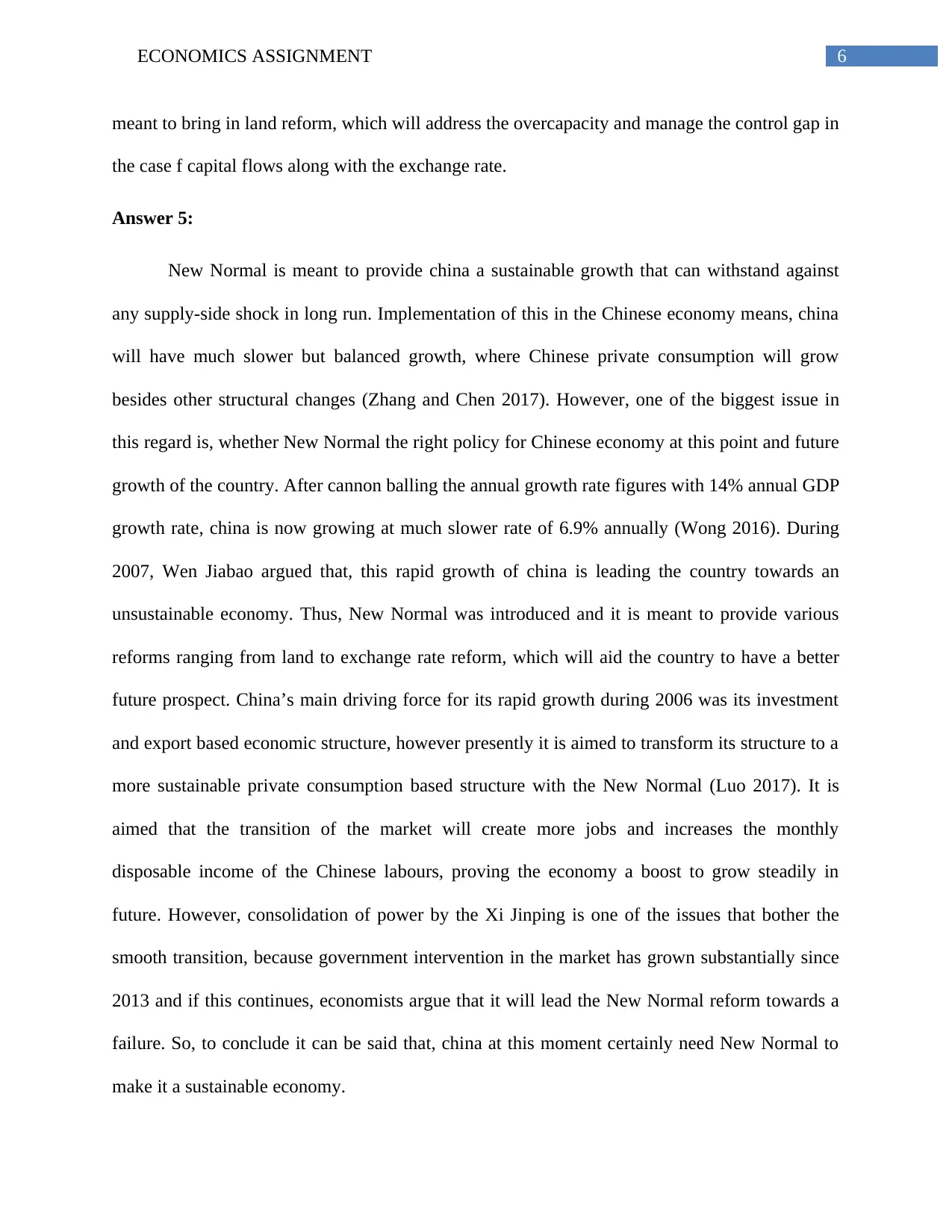
6ECONOMICS ASSIGNMENT
meant to bring in land reform, which will address the overcapacity and manage the control gap in
the case f capital flows along with the exchange rate.
Answer 5:
New Normal is meant to provide china a sustainable growth that can withstand against
any supply-side shock in long run. Implementation of this in the Chinese economy means, china
will have much slower but balanced growth, where Chinese private consumption will grow
besides other structural changes (Zhang and Chen 2017). However, one of the biggest issue in
this regard is, whether New Normal the right policy for Chinese economy at this point and future
growth of the country. After cannon balling the annual growth rate figures with 14% annual GDP
growth rate, china is now growing at much slower rate of 6.9% annually (Wong 2016). During
2007, Wen Jiabao argued that, this rapid growth of china is leading the country towards an
unsustainable economy. Thus, New Normal was introduced and it is meant to provide various
reforms ranging from land to exchange rate reform, which will aid the country to have a better
future prospect. China’s main driving force for its rapid growth during 2006 was its investment
and export based economic structure, however presently it is aimed to transform its structure to a
more sustainable private consumption based structure with the New Normal (Luo 2017). It is
aimed that the transition of the market will create more jobs and increases the monthly
disposable income of the Chinese labours, proving the economy a boost to grow steadily in
future. However, consolidation of power by the Xi Jinping is one of the issues that bother the
smooth transition, because government intervention in the market has grown substantially since
2013 and if this continues, economists argue that it will lead the New Normal reform towards a
failure. So, to conclude it can be said that, china at this moment certainly need New Normal to
make it a sustainable economy.
meant to bring in land reform, which will address the overcapacity and manage the control gap in
the case f capital flows along with the exchange rate.
Answer 5:
New Normal is meant to provide china a sustainable growth that can withstand against
any supply-side shock in long run. Implementation of this in the Chinese economy means, china
will have much slower but balanced growth, where Chinese private consumption will grow
besides other structural changes (Zhang and Chen 2017). However, one of the biggest issue in
this regard is, whether New Normal the right policy for Chinese economy at this point and future
growth of the country. After cannon balling the annual growth rate figures with 14% annual GDP
growth rate, china is now growing at much slower rate of 6.9% annually (Wong 2016). During
2007, Wen Jiabao argued that, this rapid growth of china is leading the country towards an
unsustainable economy. Thus, New Normal was introduced and it is meant to provide various
reforms ranging from land to exchange rate reform, which will aid the country to have a better
future prospect. China’s main driving force for its rapid growth during 2006 was its investment
and export based economic structure, however presently it is aimed to transform its structure to a
more sustainable private consumption based structure with the New Normal (Luo 2017). It is
aimed that the transition of the market will create more jobs and increases the monthly
disposable income of the Chinese labours, proving the economy a boost to grow steadily in
future. However, consolidation of power by the Xi Jinping is one of the issues that bother the
smooth transition, because government intervention in the market has grown substantially since
2013 and if this continues, economists argue that it will lead the New Normal reform towards a
failure. So, to conclude it can be said that, china at this moment certainly need New Normal to
make it a sustainable economy.
Paraphrase This Document
Need a fresh take? Get an instant paraphrase of this document with our AI Paraphraser
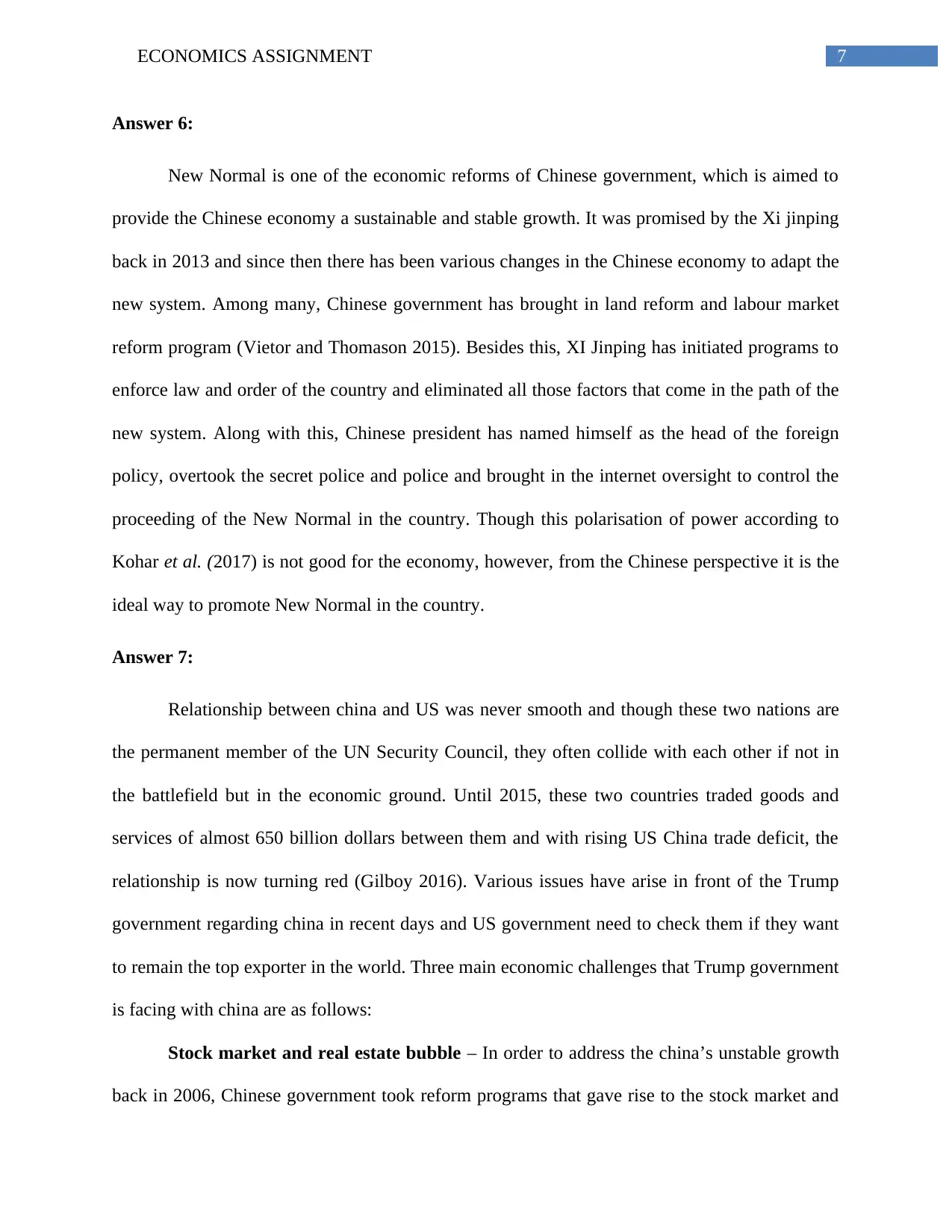
7ECONOMICS ASSIGNMENT
Answer 6:
New Normal is one of the economic reforms of Chinese government, which is aimed to
provide the Chinese economy a sustainable and stable growth. It was promised by the Xi jinping
back in 2013 and since then there has been various changes in the Chinese economy to adapt the
new system. Among many, Chinese government has brought in land reform and labour market
reform program (Vietor and Thomason 2015). Besides this, XI Jinping has initiated programs to
enforce law and order of the country and eliminated all those factors that come in the path of the
new system. Along with this, Chinese president has named himself as the head of the foreign
policy, overtook the secret police and police and brought in the internet oversight to control the
proceeding of the New Normal in the country. Though this polarisation of power according to
Kohar et al. (2017) is not good for the economy, however, from the Chinese perspective it is the
ideal way to promote New Normal in the country.
Answer 7:
Relationship between china and US was never smooth and though these two nations are
the permanent member of the UN Security Council, they often collide with each other if not in
the battlefield but in the economic ground. Until 2015, these two countries traded goods and
services of almost 650 billion dollars between them and with rising US China trade deficit, the
relationship is now turning red (Gilboy 2016). Various issues have arise in front of the Trump
government regarding china in recent days and US government need to check them if they want
to remain the top exporter in the world. Three main economic challenges that Trump government
is facing with china are as follows:
Stock market and real estate bubble – In order to address the china’s unstable growth
back in 2006, Chinese government took reform programs that gave rise to the stock market and
Answer 6:
New Normal is one of the economic reforms of Chinese government, which is aimed to
provide the Chinese economy a sustainable and stable growth. It was promised by the Xi jinping
back in 2013 and since then there has been various changes in the Chinese economy to adapt the
new system. Among many, Chinese government has brought in land reform and labour market
reform program (Vietor and Thomason 2015). Besides this, XI Jinping has initiated programs to
enforce law and order of the country and eliminated all those factors that come in the path of the
new system. Along with this, Chinese president has named himself as the head of the foreign
policy, overtook the secret police and police and brought in the internet oversight to control the
proceeding of the New Normal in the country. Though this polarisation of power according to
Kohar et al. (2017) is not good for the economy, however, from the Chinese perspective it is the
ideal way to promote New Normal in the country.
Answer 7:
Relationship between china and US was never smooth and though these two nations are
the permanent member of the UN Security Council, they often collide with each other if not in
the battlefield but in the economic ground. Until 2015, these two countries traded goods and
services of almost 650 billion dollars between them and with rising US China trade deficit, the
relationship is now turning red (Gilboy 2016). Various issues have arise in front of the Trump
government regarding china in recent days and US government need to check them if they want
to remain the top exporter in the world. Three main economic challenges that Trump government
is facing with china are as follows:
Stock market and real estate bubble – In order to address the china’s unstable growth
back in 2006, Chinese government took reform programs that gave rise to the stock market and
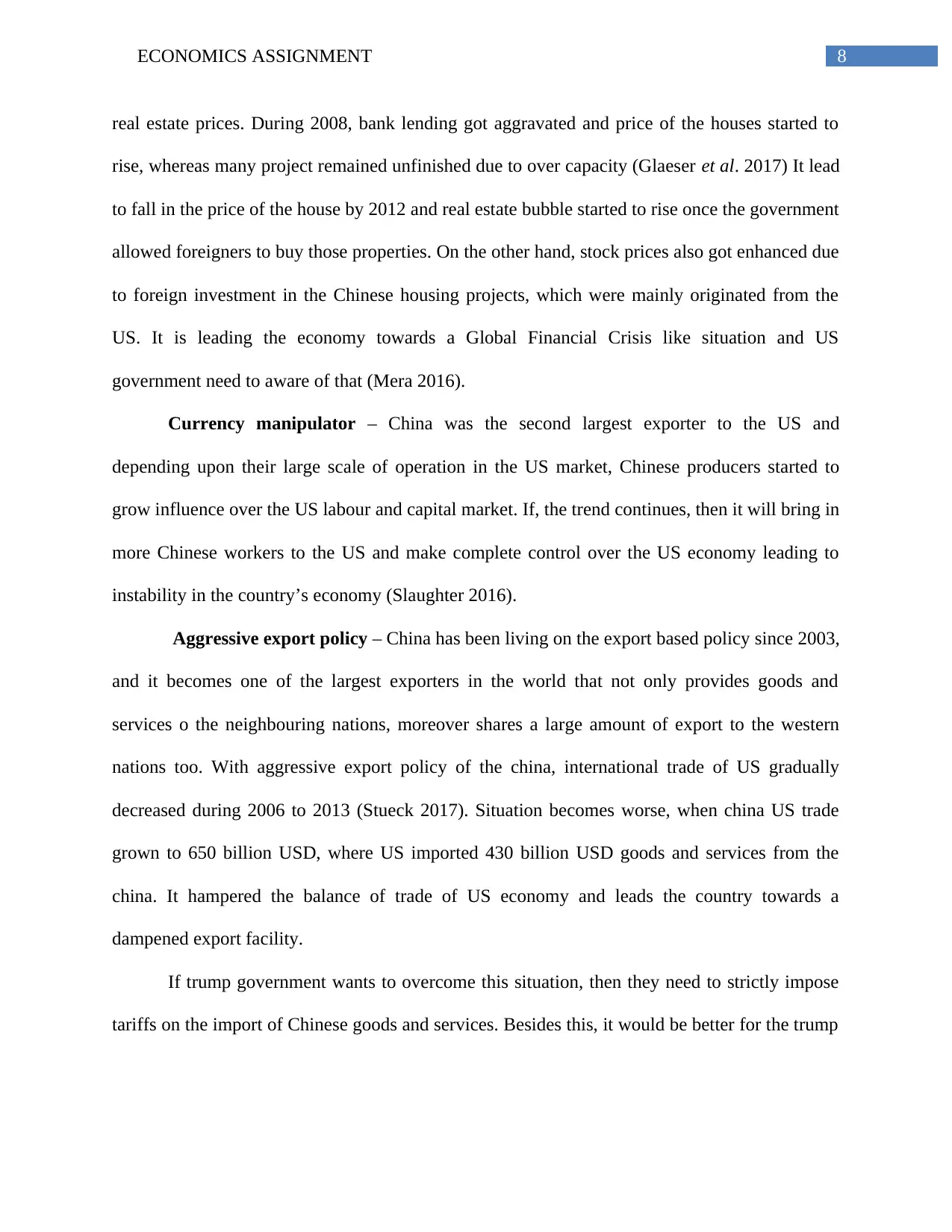
8ECONOMICS ASSIGNMENT
real estate prices. During 2008, bank lending got aggravated and price of the houses started to
rise, whereas many project remained unfinished due to over capacity (Glaeser et al. 2017) It lead
to fall in the price of the house by 2012 and real estate bubble started to rise once the government
allowed foreigners to buy those properties. On the other hand, stock prices also got enhanced due
to foreign investment in the Chinese housing projects, which were mainly originated from the
US. It is leading the economy towards a Global Financial Crisis like situation and US
government need to aware of that (Mera 2016).
Currency manipulator – China was the second largest exporter to the US and
depending upon their large scale of operation in the US market, Chinese producers started to
grow influence over the US labour and capital market. If, the trend continues, then it will bring in
more Chinese workers to the US and make complete control over the US economy leading to
instability in the country’s economy (Slaughter 2016).
Aggressive export policy – China has been living on the export based policy since 2003,
and it becomes one of the largest exporters in the world that not only provides goods and
services o the neighbouring nations, moreover shares a large amount of export to the western
nations too. With aggressive export policy of the china, international trade of US gradually
decreased during 2006 to 2013 (Stueck 2017). Situation becomes worse, when china US trade
grown to 650 billion USD, where US imported 430 billion USD goods and services from the
china. It hampered the balance of trade of US economy and leads the country towards a
dampened export facility.
If trump government wants to overcome this situation, then they need to strictly impose
tariffs on the import of Chinese goods and services. Besides this, it would be better for the trump
real estate prices. During 2008, bank lending got aggravated and price of the houses started to
rise, whereas many project remained unfinished due to over capacity (Glaeser et al. 2017) It lead
to fall in the price of the house by 2012 and real estate bubble started to rise once the government
allowed foreigners to buy those properties. On the other hand, stock prices also got enhanced due
to foreign investment in the Chinese housing projects, which were mainly originated from the
US. It is leading the economy towards a Global Financial Crisis like situation and US
government need to aware of that (Mera 2016).
Currency manipulator – China was the second largest exporter to the US and
depending upon their large scale of operation in the US market, Chinese producers started to
grow influence over the US labour and capital market. If, the trend continues, then it will bring in
more Chinese workers to the US and make complete control over the US economy leading to
instability in the country’s economy (Slaughter 2016).
Aggressive export policy – China has been living on the export based policy since 2003,
and it becomes one of the largest exporters in the world that not only provides goods and
services o the neighbouring nations, moreover shares a large amount of export to the western
nations too. With aggressive export policy of the china, international trade of US gradually
decreased during 2006 to 2013 (Stueck 2017). Situation becomes worse, when china US trade
grown to 650 billion USD, where US imported 430 billion USD goods and services from the
china. It hampered the balance of trade of US economy and leads the country towards a
dampened export facility.
If trump government wants to overcome this situation, then they need to strictly impose
tariffs on the import of Chinese goods and services. Besides this, it would be better for the trump
⊘ This is a preview!⊘
Do you want full access?
Subscribe today to unlock all pages.

Trusted by 1+ million students worldwide
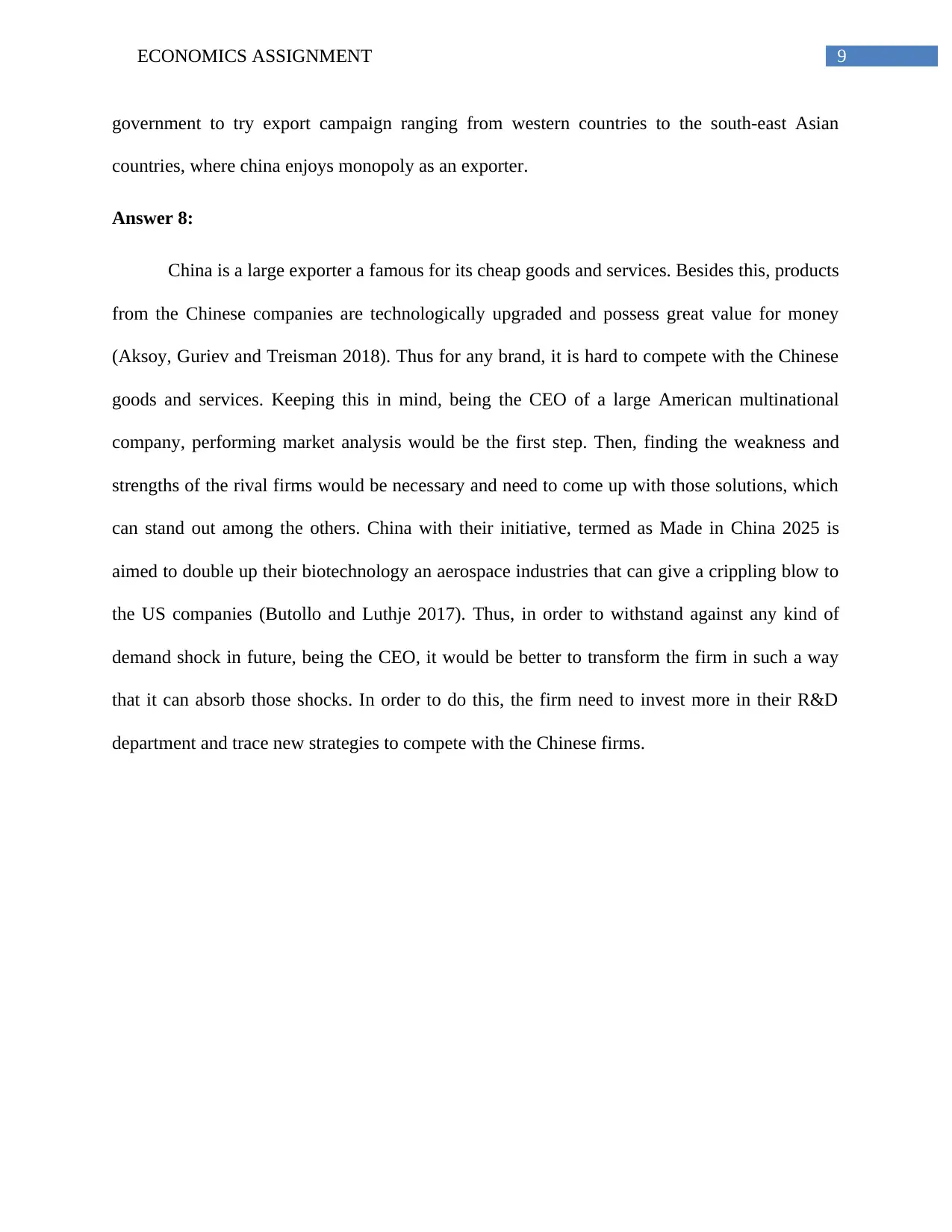
9ECONOMICS ASSIGNMENT
government to try export campaign ranging from western countries to the south-east Asian
countries, where china enjoys monopoly as an exporter.
Answer 8:
China is a large exporter a famous for its cheap goods and services. Besides this, products
from the Chinese companies are technologically upgraded and possess great value for money
(Aksoy, Guriev and Treisman 2018). Thus for any brand, it is hard to compete with the Chinese
goods and services. Keeping this in mind, being the CEO of a large American multinational
company, performing market analysis would be the first step. Then, finding the weakness and
strengths of the rival firms would be necessary and need to come up with those solutions, which
can stand out among the others. China with their initiative, termed as Made in China 2025 is
aimed to double up their biotechnology an aerospace industries that can give a crippling blow to
the US companies (Butollo and Luthje 2017). Thus, in order to withstand against any kind of
demand shock in future, being the CEO, it would be better to transform the firm in such a way
that it can absorb those shocks. In order to do this, the firm need to invest more in their R&D
department and trace new strategies to compete with the Chinese firms.
government to try export campaign ranging from western countries to the south-east Asian
countries, where china enjoys monopoly as an exporter.
Answer 8:
China is a large exporter a famous for its cheap goods and services. Besides this, products
from the Chinese companies are technologically upgraded and possess great value for money
(Aksoy, Guriev and Treisman 2018). Thus for any brand, it is hard to compete with the Chinese
goods and services. Keeping this in mind, being the CEO of a large American multinational
company, performing market analysis would be the first step. Then, finding the weakness and
strengths of the rival firms would be necessary and need to come up with those solutions, which
can stand out among the others. China with their initiative, termed as Made in China 2025 is
aimed to double up their biotechnology an aerospace industries that can give a crippling blow to
the US companies (Butollo and Luthje 2017). Thus, in order to withstand against any kind of
demand shock in future, being the CEO, it would be better to transform the firm in such a way
that it can absorb those shocks. In order to do this, the firm need to invest more in their R&D
department and trace new strategies to compete with the Chinese firms.
Paraphrase This Document
Need a fresh take? Get an instant paraphrase of this document with our AI Paraphraser
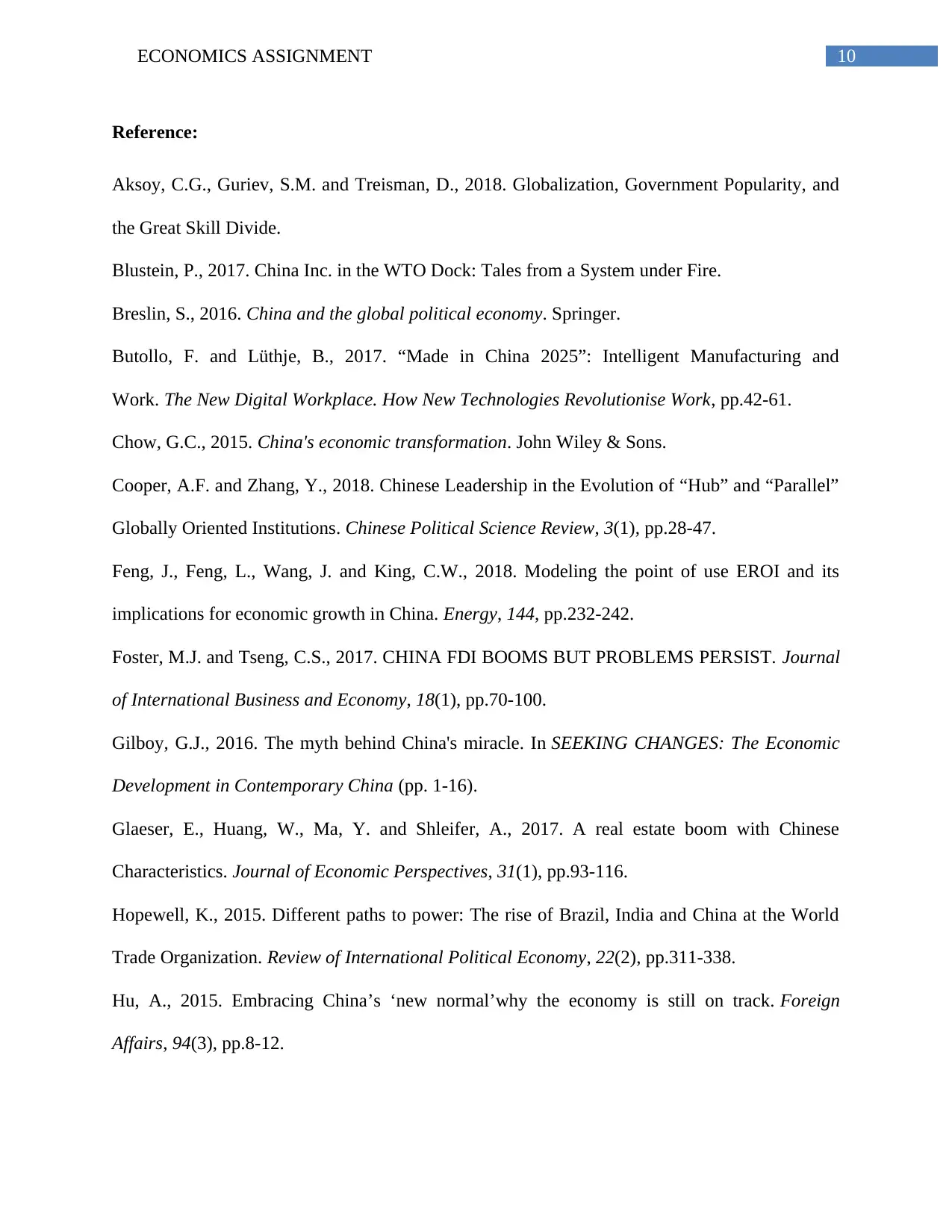
10ECONOMICS ASSIGNMENT
Reference:
Aksoy, C.G., Guriev, S.M. and Treisman, D., 2018. Globalization, Government Popularity, and
the Great Skill Divide.
Blustein, P., 2017. China Inc. in the WTO Dock: Tales from a System under Fire.
Breslin, S., 2016. China and the global political economy. Springer.
Butollo, F. and Lüthje, B., 2017. “Made in China 2025”: Intelligent Manufacturing and
Work. The New Digital Workplace. How New Technologies Revolutionise Work, pp.42-61.
Chow, G.C., 2015. China's economic transformation. John Wiley & Sons.
Cooper, A.F. and Zhang, Y., 2018. Chinese Leadership in the Evolution of “Hub” and “Parallel”
Globally Oriented Institutions. Chinese Political Science Review, 3(1), pp.28-47.
Feng, J., Feng, L., Wang, J. and King, C.W., 2018. Modeling the point of use EROI and its
implications for economic growth in China. Energy, 144, pp.232-242.
Foster, M.J. and Tseng, C.S., 2017. CHINA FDI BOOMS BUT PROBLEMS PERSIST. Journal
of International Business and Economy, 18(1), pp.70-100.
Gilboy, G.J., 2016. The myth behind China's miracle. In SEEKING CHANGES: The Economic
Development in Contemporary China (pp. 1-16).
Glaeser, E., Huang, W., Ma, Y. and Shleifer, A., 2017. A real estate boom with Chinese
Characteristics. Journal of Economic Perspectives, 31(1), pp.93-116.
Hopewell, K., 2015. Different paths to power: The rise of Brazil, India and China at the World
Trade Organization. Review of International Political Economy, 22(2), pp.311-338.
Hu, A., 2015. Embracing China’s ‘new normal’why the economy is still on track. Foreign
Affairs, 94(3), pp.8-12.
Reference:
Aksoy, C.G., Guriev, S.M. and Treisman, D., 2018. Globalization, Government Popularity, and
the Great Skill Divide.
Blustein, P., 2017. China Inc. in the WTO Dock: Tales from a System under Fire.
Breslin, S., 2016. China and the global political economy. Springer.
Butollo, F. and Lüthje, B., 2017. “Made in China 2025”: Intelligent Manufacturing and
Work. The New Digital Workplace. How New Technologies Revolutionise Work, pp.42-61.
Chow, G.C., 2015. China's economic transformation. John Wiley & Sons.
Cooper, A.F. and Zhang, Y., 2018. Chinese Leadership in the Evolution of “Hub” and “Parallel”
Globally Oriented Institutions. Chinese Political Science Review, 3(1), pp.28-47.
Feng, J., Feng, L., Wang, J. and King, C.W., 2018. Modeling the point of use EROI and its
implications for economic growth in China. Energy, 144, pp.232-242.
Foster, M.J. and Tseng, C.S., 2017. CHINA FDI BOOMS BUT PROBLEMS PERSIST. Journal
of International Business and Economy, 18(1), pp.70-100.
Gilboy, G.J., 2016. The myth behind China's miracle. In SEEKING CHANGES: The Economic
Development in Contemporary China (pp. 1-16).
Glaeser, E., Huang, W., Ma, Y. and Shleifer, A., 2017. A real estate boom with Chinese
Characteristics. Journal of Economic Perspectives, 31(1), pp.93-116.
Hopewell, K., 2015. Different paths to power: The rise of Brazil, India and China at the World
Trade Organization. Review of International Political Economy, 22(2), pp.311-338.
Hu, A., 2015. Embracing China’s ‘new normal’why the economy is still on track. Foreign
Affairs, 94(3), pp.8-12.
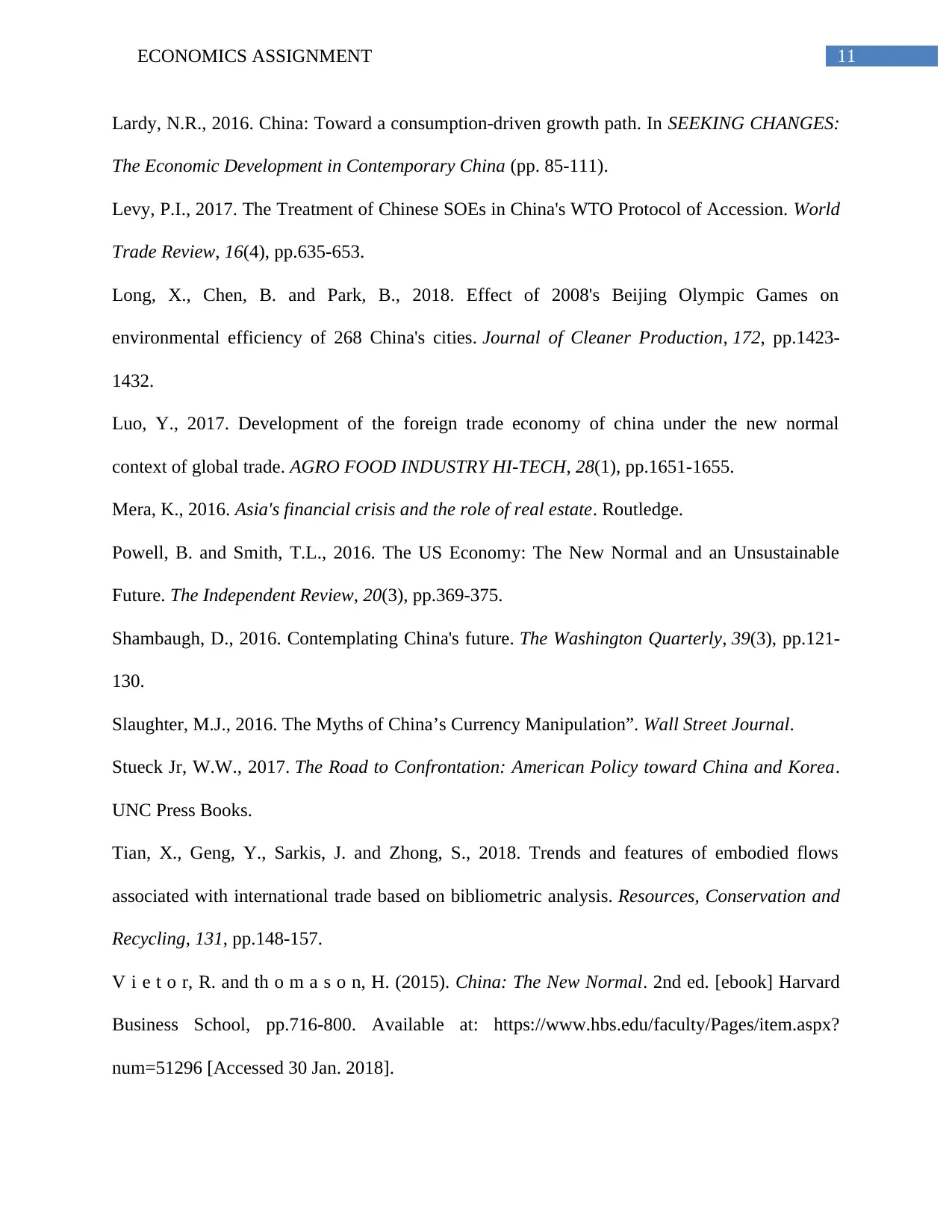
11ECONOMICS ASSIGNMENT
Lardy, N.R., 2016. China: Toward a consumption-driven growth path. In SEEKING CHANGES:
The Economic Development in Contemporary China (pp. 85-111).
Levy, P.I., 2017. The Treatment of Chinese SOEs in China's WTO Protocol of Accession. World
Trade Review, 16(4), pp.635-653.
Long, X., Chen, B. and Park, B., 2018. Effect of 2008's Beijing Olympic Games on
environmental efficiency of 268 China's cities. Journal of Cleaner Production, 172, pp.1423-
1432.
Luo, Y., 2017. Development of the foreign trade economy of china under the new normal
context of global trade. AGRO FOOD INDUSTRY HI-TECH, 28(1), pp.1651-1655.
Mera, K., 2016. Asia's financial crisis and the role of real estate. Routledge.
Powell, B. and Smith, T.L., 2016. The US Economy: The New Normal and an Unsustainable
Future. The Independent Review, 20(3), pp.369-375.
Shambaugh, D., 2016. Contemplating China's future. The Washington Quarterly, 39(3), pp.121-
130.
Slaughter, M.J., 2016. The Myths of China’s Currency Manipulation”. Wall Street Journal.
Stueck Jr, W.W., 2017. The Road to Confrontation: American Policy toward China and Korea.
UNC Press Books.
Tian, X., Geng, Y., Sarkis, J. and Zhong, S., 2018. Trends and features of embodied flows
associated with international trade based on bibliometric analysis. Resources, Conservation and
Recycling, 131, pp.148-157.
V i e t o r, R. and th o m a s o n, H. (2015). China: The New Normal. 2nd ed. [ebook] Harvard
Business School, pp.716-800. Available at: https://www.hbs.edu/faculty/Pages/item.aspx?
num=51296 [Accessed 30 Jan. 2018].
Lardy, N.R., 2016. China: Toward a consumption-driven growth path. In SEEKING CHANGES:
The Economic Development in Contemporary China (pp. 85-111).
Levy, P.I., 2017. The Treatment of Chinese SOEs in China's WTO Protocol of Accession. World
Trade Review, 16(4), pp.635-653.
Long, X., Chen, B. and Park, B., 2018. Effect of 2008's Beijing Olympic Games on
environmental efficiency of 268 China's cities. Journal of Cleaner Production, 172, pp.1423-
1432.
Luo, Y., 2017. Development of the foreign trade economy of china under the new normal
context of global trade. AGRO FOOD INDUSTRY HI-TECH, 28(1), pp.1651-1655.
Mera, K., 2016. Asia's financial crisis and the role of real estate. Routledge.
Powell, B. and Smith, T.L., 2016. The US Economy: The New Normal and an Unsustainable
Future. The Independent Review, 20(3), pp.369-375.
Shambaugh, D., 2016. Contemplating China's future. The Washington Quarterly, 39(3), pp.121-
130.
Slaughter, M.J., 2016. The Myths of China’s Currency Manipulation”. Wall Street Journal.
Stueck Jr, W.W., 2017. The Road to Confrontation: American Policy toward China and Korea.
UNC Press Books.
Tian, X., Geng, Y., Sarkis, J. and Zhong, S., 2018. Trends and features of embodied flows
associated with international trade based on bibliometric analysis. Resources, Conservation and
Recycling, 131, pp.148-157.
V i e t o r, R. and th o m a s o n, H. (2015). China: The New Normal. 2nd ed. [ebook] Harvard
Business School, pp.716-800. Available at: https://www.hbs.edu/faculty/Pages/item.aspx?
num=51296 [Accessed 30 Jan. 2018].
⊘ This is a preview!⊘
Do you want full access?
Subscribe today to unlock all pages.

Trusted by 1+ million students worldwide
1 out of 13
Related Documents
Your All-in-One AI-Powered Toolkit for Academic Success.
+13062052269
info@desklib.com
Available 24*7 on WhatsApp / Email
![[object Object]](/_next/static/media/star-bottom.7253800d.svg)
Unlock your academic potential
Copyright © 2020–2025 A2Z Services. All Rights Reserved. Developed and managed by ZUCOL.





